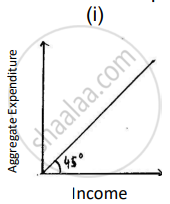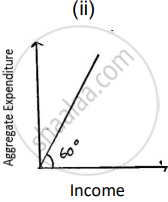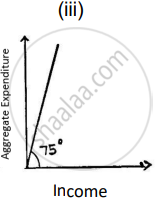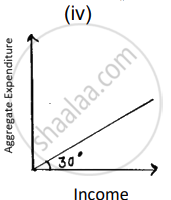Commerce (English Medium)
Arts (English Medium)
Academic Year: 2024-2025
Date: March 2025
Advertisements
GENERAL INSTRUCTIONS:
- This question paper contains two sections:
Section A – Macro Economics
Section B – Indian Economic Development - This paper contains 20 Multiple Choice Type Questions of 1 mark each.
- This paper contains 4 Short Answer Type Questions of 3 marks each to be answered in 60 to 80 words.
- This paper contains 6 Short Answer Type Questions of 4 marks each to be answered in 80 to 100 words.
- This paper contains 4 Long Answer Type Questions of 6 marks each to be answered in 100 to 150 words.
Assertion (A): The government can reduce the deflationary gap by purchasing government securities in the open market.
Reason (R): The Central Bank purchases government securities in the open market to increase the lending capacity of commercial banks.
Both Assertion (A) and Reason (R) are true and Reason (R) is the correct explanation of Assertion (A).
Both Assertion (A) and Reason (R) are true, but Reason (R) is not the correct explanation of Assertion (A).
Assertion (A) is true, but Reason (R) is false.
Assertion (A) is false, but Reason (R) is true.
Chapter:
|
“The Cabinet led by Prime Minister has decided that the Central Government will provide free food grains to 81.35 crore (approx.) beneficiaries under the Pradhan Mantri Garib Kalyan Anna Yojana (PMGKAY) for a period of five years with effect from 1st January, 2024.” |
Based on the aforesaid statement, identify the budgetary objective the government is trying to achieve and choose the correct option:
Reallocation of resources
Economic stability
Redistribution of income
Economic instability
Chapter:
To arrive at the value of Gross Value Added at Market Price (GVAMP) ______ must be added to Gross Value Added (GVA) at Basic Prices.
Product Taxes
Net Product Taxes
Production Taxes
Net Production Taxes
Chapter:
Under the ________ exchange rate system, market forces automatically adjust the surplus and deficit in the Balance of Payments account.
fixed
flexible
managed floating
dirty floating
Chapter:
From the given diagrams, identify the correct option that indicates the ‘Reference Line’ passing through the origin drawn at a particular angle.
(i)
(ii)
(iii)
(iv)
Chapter:
| As per the data presented in the Union Budget 2023-24, the total receipts of the government other than borrowings and the total expenditure are estimated at ₹ 27.2 lakh crore and ₹ 45 lakh crore respectively. |
The value of the ________ deficit would be ₹ 17.8 lakh crore.
revenue
fiscal
budgetary
primary
Chapter:
Statement 1: The maximum value of Marginal Propensity to Consume (MPC) can be unity.
Statement 2: As the income of an economy increases, the proportionate increase in the level of consumption is always more than the increase in the level of income.
Statement 1 is true and Statement 2 is false.
Statement 1 is false and Statement 2 is true.
Both Statements 1 and 2 are true.
Both Statements 1 and 2 are false.
Chapter:
In a two-sector economy, Aggregate Demand can be determined by adding _______.
Autonomous Consumption, Induced Consumption and Induced Investment.
Autonomous Consumption, Autonomous Investment and Induced Investment.
Autonomous Consumption and Autonomous Investment.
Autonomous Consumption, Induced Consumption and Autonomous Investment.
Chapter:
Statement 1: Foreign grants-in-aid receipts do not lead to any claim on the government.
Statement 2: Disposal of equity by the Public Sector Undertakings in the market may lead to a decrease in the assets of the government.
Statement 1 is true and Statement 2 is false.
Statement 1 is false and Statement 2 is true.
Both Statements 1 and 2 are true.
Both Statements 1 and 2 are false.
Chapter:
Based on the given diagram:
The trade under current account during January 2024 reflects a ______ of USD _____ billion.
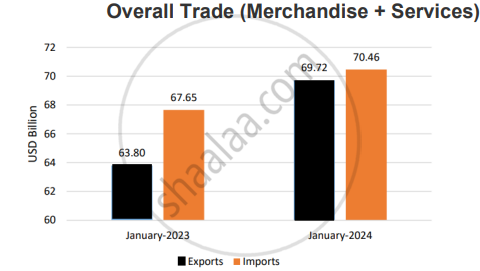
surplus, 0.74
surplus, 3.85
deficit, 0.74
deficit, 3.85
Chapter:
On the basis of the given data, estimate the value of Domestic Income (NDPFC):
| S.No. | Items | Amount (₹ in crore) |
| i. | Household Consumption Expenditure | 800 |
| ii. | Gross Business Fixed Capital Formation | 150 |
| iii. | Gross Residential Construction Investment | 120 |
| iv. | Government Final Consumption Expenditure | 170 |
| v. | Excess of Imports over Exports | 20 |
| vi. | Inventory Investment | 140 |
| vii. | Gross Public Investment | 500 |
| viii. | Net Indirect Taxes | 70 |
| ix. | Net Factor Income From Abroad | (-) 50 |
| x. | Consumption of Fixed Capital | 40 |
Chapter:
State the steps pertaining to the estimation of National Income under the income method.
Chapter:
“Tax revenue collection of the government may be categorized under two heads.”
State and explain the two heads of tax revenue.
Chapter:
‘Foreign Portfolio Investment (FPI) witnessed a sharp turnaround during 2023-24 with net FPI inflows of US$ 32.4 billion.’
In which sub-account and on which side of the Balance of Payments account the above transaction will be recorded? Give reasons in support of your answer.
Chapter:
Explain the meaning of balance of payments deficit.
Chapter: [0.06] Open Economy Macroeconomics
Advertisements
“Saving curve can be derived from the consumption curve”
Justify the statement, citing valid steps with the help of a well-labelled diagram.
Chapter:
| For two hypothetical economies A and B, the value of Marginal Propensity to Consume (MPC) stands at 0.6 and 0.8 respectively. Assuming for both the economies, Autonomous Consumption (c̅) to be ₹ 40 crore and Investment Expenditure (I) to be ₹ 100 crore. |
Calculate:
- Break-even level of income for Economy A
- Equilibrium level of income for Economy B
Chapter:
"Union Finance Minister stated, that investments in infrastructure and productive capacity have a large multiplier impact on growth and employment and in view of this, capital investment outlay is being proposed to increase steeply in the Budget 2023-24 by 1,000 crore.”
Based on the given text and common understanding, explain the working process of the increase in investment on the National Income, assuming the Marginal Propensity to Save (MPS) as 20%.
Chapter:
As societies developed from hunters and gatherers, the material needs of human beings increased – to build a house, wear clothes, make weapons and implements etc. Since these needs could not be produced individually, people had to purchase them from others. These purchases, for example, were paid initially by barter – a leather skin cloak for a spear. As barter had its limits – how many cloaks for a spear – barter got standardized in terms of metals or cowrie shells. Now people knew the value of both the cloak and the spear in terms of bronze or cowrie shells. This was still barter, as both bronze and shells had intrinsic value (shells were desired for their beauty). This system evolved over time into metal currencies. Gold and silver coinage were the offshoot of this system where they had features of barter (both gold and silver had intrinsic value) as well as money (they were standardized representation of value).
In respect of money two facts emerge historically:
- Money has taken the form of either commodities (which have intrinsic value) or in terms of debt instruments.
- Money is usually issued by a sovereign (or a Central Bank as its representative).
In modern economies, currency is a form of money that is issued exclusively by some competent authority (Central Bank). It is a liability of the issuing Central Bank and an asset of the holding public. Currency is usually issued in paper (or polymer) form, but the form of currency is not its defining characteristic.
In the recent past, the Reserve Bank of India, issued Central Bank Digital Currency (CBDC). A CBDC is the currency issued by a central bank in a digital form. It serves all the purposes of a paper currency in a different form. The introduction of CBDC has the potential to provide significant benefits, such as reduced dependency on cash, lower transaction costs, reduced settlement risk. Introduction of CBDC would possibly lead to a more robust, efficient, trusted, regulated payments option. There are associated risks such as cyber-attacks and technology preparedness, but they need to be carefully evaluated against the potential benefits.
On the basis of the given text and common understanding, answer the following questions:
- “Over the centuries, money has evolved in various forms".
In the light of the given statement, state and discuss briefly any two forms of money. - “Various economists have formed a strong opinion that, in the modern times digital currency (like CBDC) is quite essential. However, it comes with its own benefits and potential risks.”
Do you agree with the given statement, giving valid arguments in support of your answer.
Chapter:
- On the basis of the following hypothetical data: (all figures in ₹ crore)
Calculate the percentage change in Real Gross Domestic Product in the year 2023 using 2020 as the base year.Year Nominal GDP Nominal GDP adjusted to base year prices 2020 3,000 4,000 2023 4,000 4,500 - “The public investment on the construction of a multi-lane flyover may reduce traffic congestion.”
On the basis of the above statement, discuss its likely impact on Gross Domestic Product (GDP) and welfare in an economy.
Chapter:
“Basis of classification of final goods into consumption and capital goods depend on the economic nature of its use.”
Defend or refute the statement, with the help of a suitable example.
Chapter:
“Basis of classification of final goods into consumption and capital goods depend on the economic nature of its use.”
Defend or refute the statement, with the help of a suitable example.
Chapter:
Read the given image carefully:
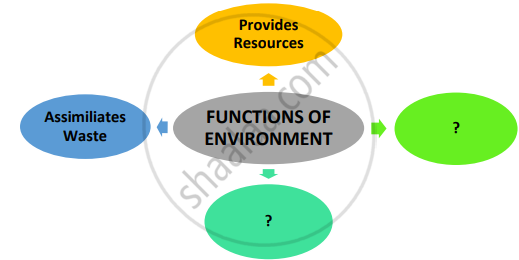
Choose the correct option which indicates the combination of vital functions performed by the environment.
- Sustains life
- Provides aesthetic services
- Generates waste
- Provides only renewable resources
(i) and (ii)
(ii) and (iii)
(i) and (iv)
(i) and (iii)
Chapter:
Statement 1: The British policies led to the collapse of India’s world-famous handicraft industries.
Statement 2: During the colonial rule in India, the contribution of the industrial sector to Gross Value Added (GVA) increased significantly.
Statement 1 is true and Statement 2 is false.
Statement 1 is false and Statement 2 is true.
Both Statements 1 and 2 are true.
Both Statements 1 and 2 are false.
Chapter:
Assertion (A): The Education Commission (1964–66) had recommended that at least 4% of Gross Domestic Product (GDP) be spent on education.
Reason (R): The Union and State Governments, have been stepping up expenditures in the education sector over the years to fulfil the objective of attaining cent per cent literacy.
Both Assertion (A) and Reason (R) are true and Reason (R) is the correct explanation of Assertion (A).
Both Assertion (A) and Reason (R) are true, but Reason (R) is not the correct explanation of Assertion (A).
Assertion (A) is true, but Reason (R) is false.
Assertion (A) is false, but Reason (R) is true.
Chapter:
In the post-independence era, the policymakers of India adopted an economic system that fundamentally implies the coexistence of ______ and ______.
small and large-scale industries
small and medium-scale industries
public and private sector
private and foreign sector
Chapter:
The institutional structure of rural banking in contemporary India consists of a set of multi-agency institutions, namely, ___________.
- Regional Rural Banks
- Cooperative Banks
- Land Development Banks
- Commercial Banks
(i) and (iv)
(i), (iii) and (iv)
(i), (ii) and (iii)
(i), (ii), (iii), and (iv)
Chapter:
Identify, which of the following statement is incorrect about the financial sector reform introduced in 1991?
Enabled the establishment of private sector banks, Indian as well as foreign.
Foreign investment limit in banks was raised to around 74%.
Foreign Institutional Investors were allowed to invest in Indian financial markets.
Change in the role of the Reserve Bank of India from facilitator to regulator.
Chapter:
China's demographic problem of 4-2-1, resulted in a higher proportion of elderly individuals compared to the younger population. This was primarily due to the implementation of __________.
Great Leap Forward Campaign
Great Proletarian Cultural Revolution
One Child Norm
Special Economic Zones
Chapter:
_________ was setup in 1974 by the Indian government to address two major environmental concerns viz. water and air pollution.
State Pollution Control Board
Central Pollution Control Board
Brundtland Commission
Montreal Protocol
Chapter:
“Assuming in a hypothetical economy, Real Gross Domestic Product recorded a growth rate of 9% during a fiscal year. However, the economy faced a significant challenge in terms of creating an adequate number of employment opportunities.”
Identify the situation indicated in the given statement and choose the correct option.
Casualisation of workforce
Informalisation of workforce
Formalisation of workforce
Jobless growth
Chapter:
Advertisements
During the period 1951-2016, ___________ led to an increase in the milk production in India by about ten times.
Green Revolution
Golden Revolution
Operation Flood
Industrial Revolution
Chapter:
Critically appraise the disinvestment policy initiated by the government during the reforms of 1991.
Chapter:
‘Globalisation is an essential outcome of liberalisation of an economy’.
Justify the given statement with a valid explanation.
Chapter:
‘To measure the extent of development in an economy, liberty indicators should be considered along with other socio-economic parameters.’ Do you agree with the given statement? Give valid reasons in support of your answer.
Agree
Disagree
Chapter:
‘The reform process implemented in the late 1970s, commonly known as China’s open door policy, encompassed a wide range of reforms across sectors like agriculture, investment, industry etc. These reforms played a pivotal role in driving the rapid growth of the Chinese economy over subsequent decades.’
In the light of the given text, discuss any two reforms responsible for the rapid economic growth of China.
Chapter:
‘Under the Delhi Declaration, the G-20 nations pledged to reach global net zero emissions approximately by mid-century and to triple global renewable energy capacity by 2030.’
Discuss briefly the rationale behind the commitment by G-20 nations in the direction of achieving sustainable development.
Chapter:
‘It would be unclear to say that, the growth of human capital lays the ground for economic growth of a nation.’
Do you agree with the given statement? Support your answer with valid illustrations.
Agree
Disagree
Chapter:
Interpret the given picture based on the Saansad Adarsh Gram Yojana (SAGY) initiated by the Government of India.
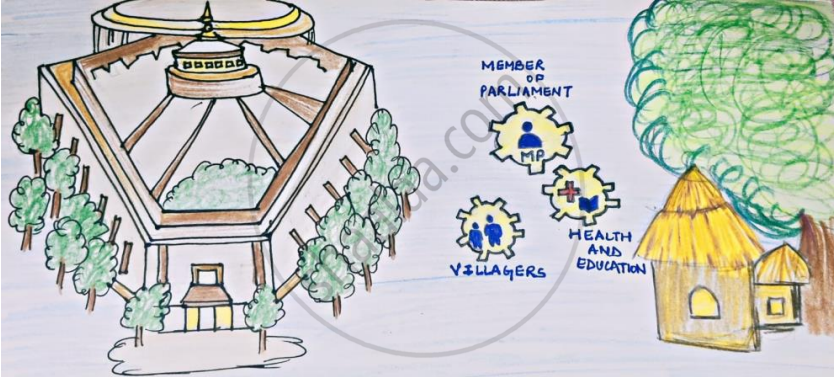
Chapter:
Read the following text carefully:
|
Employment generation has remained one of the top challenges of Indian policymakers, and over the years, this has only become more complex. India has experienced more or less consistent growth in the structure of the output of the economy, especially after the economic reforms which is measured by gross value added. However, the trend in employment did not reveal a consistent and clear pattern. These complexities have led to a wide variation in the conclusions drawn by experts and various studies on workforce and employment. |
Two major sources of data on the workforce and employment have been the
- decennial population census and
- nationwide quinquennial surveys on employment and unemployment by the erstwhile NSSO under the Ministry of Statistics and Programme Implementation (MoSPI), Government of India.
|
The nationwide Employment and Unemployment (E&U) surveys have been replaced by the Periodic Labour Force Survey (PLFS) conducted by the National Statistical Office (NSO) of MoSPI, which started in the year 2017–18. According to NSO, the PLFS data measure the dynamics in labour force participation, workers to population ratio and the employment status along with related, important parameters for both rural and urban areas. Labour force includes persons who were either working (or employed) or those available for work (or unemployed). Some persons in the labour force are abstained from work for various reasons. Deducting that number from the labour force gives the number of actual workers. These workers are further categorised as persons who are engaged in any economic activity as selfemployed or regular wage/salaried and casual labour. The difference between the labour force and the workforce gives the number of unemployed persons. The size of the labour force in the country has increased from 485.3 million in the year 2017–18 to 497.4 million in the year 2018–19. The next year, the labour force increased by 8 per cent and reached 537.9 million. This increase was witnessed across male and female populations as well as rural and urban households. |
On the basis of the given text and common understanding, answer the following questions:
- State any two major sources of data on the workforce and employment.
- ‘The labour force encompasses a broader category than the workforce.’ Defend or refute the statement, giving valid reasons in support of your answer.
- ‘Workers can be categorized into different types depending on their status.’
In the light of the given statement, state any one type of employment.
Chapter:
‘Under the Industrial Policy Resolution (IPR) 1956 in India, the system of industrial licensing was introduced to promote regional equality.’
Justify the given statement with valid arguments.
Chapter:
Discuss briefly the estimates made by notable scholars regarding the national income and per capita income during the colonial rule in India.
Chapter:
‘During the colonial period, India’s foreign trade was characterized by a large export surplus, however, this did not result in any flow of gold or silver into India.’
Justify the given statement with valid arguments.
Chapter:
Explain the rationale behind choosing 'Self-reliance' as a central planning objective in India's development strategy.
Chapter:
Other Solutions
Submit Question Paper
Help us maintain new question papers on Shaalaa.com, so we can continue to help studentsonly jpg, png and pdf files
CBSE previous year question papers Class 12 Economics with solutions 2024 - 2025
Previous year Question paper for CBSE Class 12 Economics-2025 is solved by experts. Solved question papers gives you the chance to check yourself after your mock test.
By referring the question paper Solutions for Economics, you can scale your preparation level and work on your weak areas. It will also help the candidates in developing the time-management skills. Practice makes perfect, and there is no better way to practice than to attempt previous year question paper solutions of CBSE Class 12.
How CBSE Class 12 Question Paper solutions Help Students ?
• Question paper solutions for Economics will helps students to prepare for exam.
• Question paper with answer will boost students confidence in exam time and also give you an idea About the important questions and topics to be prepared for the board exam.
• For finding solution of question papers no need to refer so multiple sources like textbook or guides.
